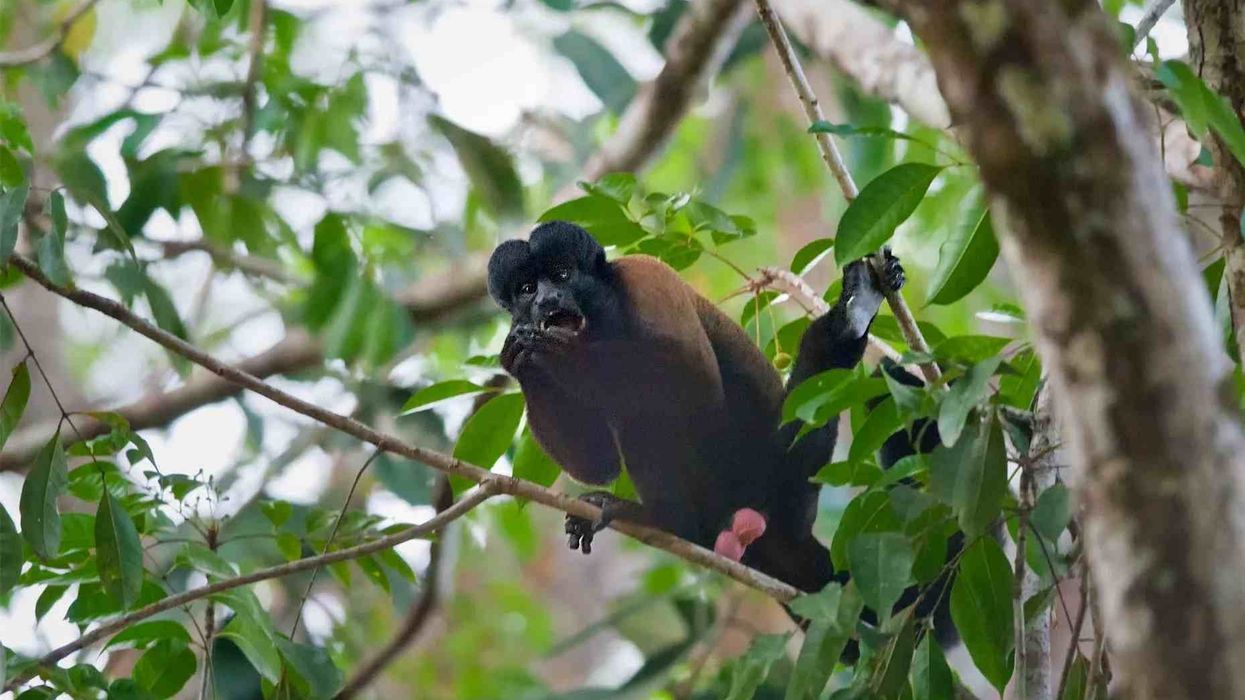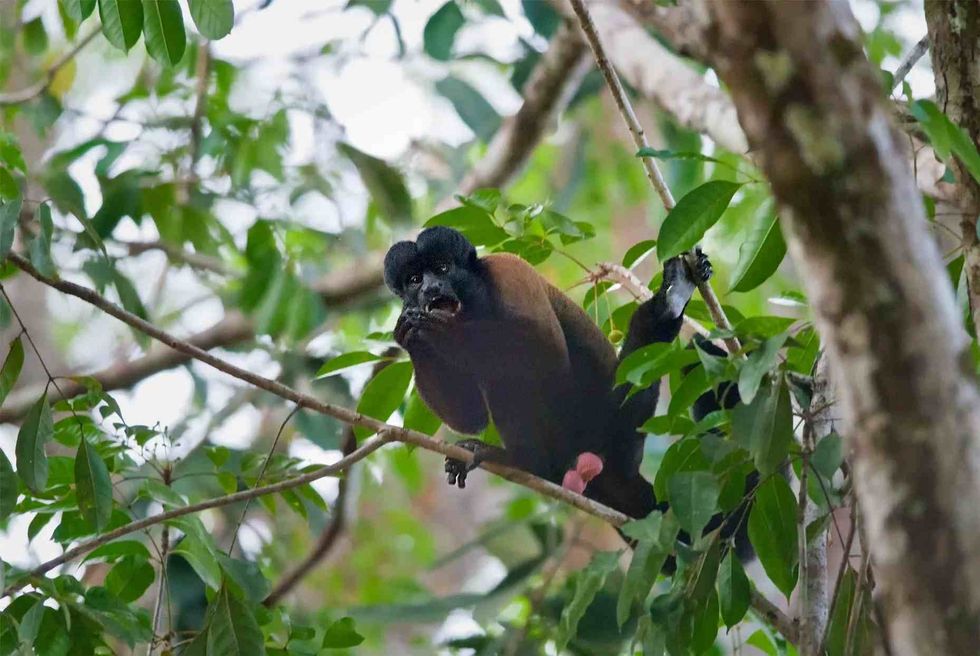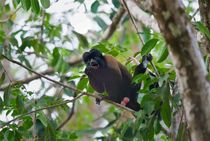Fun Bearded Saki Facts For Kids

Are you fascinated by primates? We have lots of information on bearded sakis.
Bearded saki is a genus and this genus consists of five different species. These are the white-nosed saki (Chiropotes albinasus), the Uta Hick's bearded saki (Chiropotes utahickae), the red-backed bearded saki (Chiropotes chiropotes), the brown-backed bearded saki (Chiropotes israelita), and the black-bearded saki (Chiropotes satanas).
These five species are quite similar in nature other than slight differences in their appearances. Their population numbers also differ significantly.
While there is plenty of red-backed bearded sakis and brown-backed bearded sakis in the world, the population of white-nosed sakis, Uta Hick's bearded sakis, and black-bearded sakis is pretty low. According to the American Journal of Primatology, C. Satanas or the black-bearded saki has become a victim of habitat fragmentation which has led to them becoming an Endangered species.
These harmless New World monkeys only feed on seeds, fruits, and other insect matter. In fact, seeds make up more than 50% of their diet.
Read on to know more about the bearded sakis, and if you like this article, then also check out langur monkey and Brumback's monkey facts too.
Bearded Saki Interesting Facts
What type of animal is a bearded saki?
The bearded saki is a genus of primates.
What class of animal does a bearded saki belong to?
Bearded sakis are a type of New World monkey and belong to the class Mammalia of animals.
How many bearded sakis are there in the world?
There are five different species of bearded saki under their genus. The population of white-nosed saki is low, but it is assumed that there are at least 10,000 individuals.
The population of the C. Satanas or black-bearded saki is much lower and it is assumed there are only 2500 left.
The population of the Uta Hick's bearded saki is low, and the populations of the red-backed bearded saki and the brown-backed bearded saki seem to be stable. However, the exact population of these three species in numbers is not known.
Where does a bearded saki live?
Bearded sakis are known to live in the geographical range of the eastern part of the Amazon, French Guiana, Guyana, Venezuela, Suriname, and Brazil. These primates are known to live to the furthest of the west of Pico da Neblina National Park of Brazil.
In the state of Rondônia in Brazil, to the west of Jiparaná-Pimenta Bueno River, a limited population of these primates can be found.
What is a bearded saki's habitat?
The primary habitat of these New World monkeys is high rainforest, but they can be seen living in all kinds of rainforest and other kinds of forests as well. They are found in low rainforests and terre firme rainforest.
Other than that, they also live in savannah-like forests, riparian forests, premontane forests, annually and seasonally flooded forests, mountain savannah forests, igapo forests, semi-deciduous tropical moist forests, Kanuku forest, Wallaba forest, and many more other types of forests.
Who do bearded sakis live with?
Bearded sakis are known to be social animals. They live and forage for food in a group of 10-40 individuals.
These groups are usually made up of multiple males and multiple females. These primates live in a group and have developed a system among themselves where they warn others if they sense any danger or predators. Their defense method involves many of them coming together.
How long does a bearded saki live?
The average lifespan of these new world monkeys is about 17-20 years.
How do they reproduce?
Very little information is known about the reproduction of the bearded saki due to a lack of research. The little we know about them is from bearded sakis that are living in captivity.
The breeding season differs depending on the different species.
The breeding season of the black-bearded saki is in the rainy season during the months of December and January, while the breeding season for the white-nosed saki occurs during August to September and February to March. These sakis are known to live in groups where many males and females live together, and no monogamous groups can be seen.
After copulation, the gestation period is about five months and they give birth to one offspring. The young ones begin to be independent at the age of around three to six months.
For the first two months after birth, the juveniles have a prehensile tail and after two months, the tail loses its manner. The mothers mainly take care of the young ones.
What is their conservation status?
According to the International Union for Conservation of Nature, the conservation status of the white-nosed saki (Chiropotes albinasus) and the Uta Hick's bearded saki (Chiropotes utahickae) is listed as Vulnerable. The conservation status of the red-backed bearded saki (Chiropotes chiropotes) and the brown-backed bearded saki (Chiropotes israelita) is listed as Least Concern.
The conservation status of the black-bearded saki (Chiropotes satanas) is listed as an Endangered species.
Bearded Saki Fun Facts
What do bearded sakis look like?
In general, bearded sakis are medium-sized sakis. They have thick hairy beards, bushy non-prehensile tails, and a cluster of hair on both sides of their head. The ears are usually covered by thick hair.
They have comparatively longer hair on both their shoulders and arms. The hair is usually thicker and longer in males. The five different species can be differentiated by the color of their fur which stays mostly between brown to black, and is sometimes reddish.
How cute are they?
These New World monkeys can seem cute with their little clusters of hair on the sides of the head, thick beards, and bushy tails. They are also not that aggressive. The only aggressiveness that has been seen is among the others of their own species which only adds to their charm.
How do they communicate?
Bearded sakis communicate vocally and by body language. These primates are a rather vocal bunch. They make sounds like whistles which mainly work as a signal or alarm for others of their groups.
They chirp at the time of eating, and they also make purring sounds at the time of mating. Young bearded sakis also make a purring sound to communicate with their mothers. They also communicate through body language like tail wagging which they use as a silent signal for others in their group.
How big is a bearded saki?
On average, males of the bearded saki species are about 15.3-16.8 in (39-42.7 cm) in length and females are about 14.4-16.4 in (36.6-41.8 cm) in length. Eastern gorillas are about four times larger than bearded sakis. The eastern gorilla is the largest primate and it can grow up to be about 59-72.8 in (150-185 cm) in length.
How fast can a bearded saki move?
These New World monkeys move at a moderate speed in large groups in the day to search for food. This primate is known to walk on all four legs on branches. They can be seen jumping at times from mid-movement. Generally, they do not always climb.
How much does a bearded saki weigh?
Males are usually heavier than females. Make bearded sakis weigh about 6.7 lb (3 kg), and females weigh about 5.6 lb (2.6 kg).
What are the male and female names of the species?
The males and the females of this species don't have any specific names.
What would you call a baby bearded saki?
The baby of a bearded saki does not have a specific name.
What do they eat?
Bearded sakis are omnivorous in nature and more than 50% of their diet consists of seeds. Other than that, they also feed on fruits.
At times, they have been seen eating flowers or other plant matters as well as insects. They have strong and suitable teeth to be able to break open hard-shelled fruits and many different kinds of seeds.
Are they active?
Bearded sakis stay active for the majority of the day and they are diurnal in nature. When the sun is out, this primate travels in its group in the forest canopy searching for food.
They primarily feed on seeds and fruits, so they travel in the forest canopy all day. During the dry seasons, they travel further than usual in search of food. Once they come back after the day is over, they are known to groom each other and play.
Would they make a good pet?
These are wild animals and they also live in groups. Replicating the exact required habitat of bearded sakis is not be easy, and this might harm the animals. In addition, some bearded sakis are low in population, so to preserve those species, it would be better to not try to keep them as pets.
Did you know...
Sometimes the bearded saki lives in harmony with other closely related primate species like other saki monkeys, squirrel monkeys, howler monkeys, or spider monkeys.
Sometimes when an individual is separated from the group while searching for food, it will join a group of spider monkeys or a mixed group of capuchin and squirrel monkeys.
Why is the black-bearded saki endangered?
The main reasons for black-bearded sakis (Chiropotes satanas) being an Endangered species are habitat loss, habitat fragmentation, and hunting. Compared to other species, the geographical range of the animals is quite small and fragmented, which means they are easily accessible for hunters.
They are hunted for their meat and fur. Building dams, deforestation, conversion of forests for agricultural purposes, and building highways are a few reasons for the habitat loss of the already small range of habitat they have.
What are the different types of saki and how are they different from each other?
There are five different species of bearded sakis. These are the white-nosed saki (Chiropotes albinasus), the Uta Hick's bearded saki (Chiropotes utahickae), the red-backed bearded saki (Chiropotes chiropotes), the brown-backed bearded saki (Chiropotes israelita), and the black-bearded saki (Chiropotes satanas).
The nature and behavior of these five species have not been studied or researched a lot, but for the most part, they behave the same.
The way by which these five species can be differentiated is by the color of their fur. The red-backed bearded saki species has red or orange to light brown hair on their back, sides, limbs, and tail in addition to the black fur on their bodies.
The species of white-nosed saki has black fur all over, but the upper lip and nose are a shade of white.
The Uta Hick's bearded saki species has reddish-brown to brown-colored fur all over, but their tail is blackish-brown and their beard is dark brown colored. The species of brown-backed bearded saki has black to dark brown colored fur overall, but the dorsal part of the body has buffy-brown or tawny-olive colored fur.
Lastly, the species of black-bearded saki has a black face and black to blackish-brown back, with little darker colored limbs while some lighter colors can be seen spread across the body.
Here at Kidadl, we have carefully created lots of interesting family-friendly animal facts for everyone to discover! Learn more about some other mammals from our colobus monkey facts and golden-headed lion tamarin facts pages.
You can even occupy yourself at home by coloring in one of our free printable bearded saki coloring pages.
We Want Your Photos!
More for You
See All
Bachelor of Arts specializing in Journalism and Mass Communication, Postgraduate Diploma in Sports Management

Moumita DuttaBachelor of Arts specializing in Journalism and Mass Communication, Postgraduate Diploma in Sports Management
A content writer and editor with a passion for sports, Moumita has honed her skills in producing compelling match reports and stories about sporting heroes. She holds a degree in Journalism and Mass Communication from the Indian Institute of Social Welfare and Business Management, Calcutta University, alongside a postgraduate diploma in Sports Management.
Bachelor of Arts specializing in Economics

Gowri RaoBachelor of Arts specializing in Economics
With a bachelor's degree in Economics from Krea University, Gowri is a highly skilled data analyst and an expert in regression and causation modeling. Her interests in economic trends, finance, and investment research complement her professional expertise. In addition to her professional pursuits, Gowri enjoys swimming, running, and playing the drums, and she is also a talented tutor.
Disclaimer
1) Kidadl is independent and to make our service free to you the reader we are supported by advertising. We hope you love our recommendations for products and services! What we suggest is selected independently by the Kidadl team. If you purchase using the Buy Now button we may earn a small commission. This does not influence our choices. Prices are correct and items are available at the time the article was published but we cannot guarantee that on the time of reading. Please note that Kidadl is a participant in the Amazon Services LLC Associates Program, an affiliate advertising program designed to provide a means for sites to earn advertising fees by advertising and linking to Amazon. We also link to other websites, but are not responsible for their content.
2) At Kidadl, we strive to recommend the very best activities and events. We will always aim to give you accurate information at the date of publication - however, information does change, so it’s important you do your own research, double-check and make the decision that is right for your family. We recognise that not all activities and ideas are appropriate for all children and families or in all circumstances. Our recommended activities are based on age but these are a guide. We recommend that these ideas are used as inspiration, that ideas are undertaken with appropriate adult supervision, and that each adult uses their own discretion and knowledge of their children to consider the safety and suitability. Kidadl cannot accept liability for the execution of these ideas, and parental supervision is advised at all times, as safety is paramount. Anyone using the information provided by Kidadl does so at their own risk and we can not accept liability if things go wrong.
3) Because we are an educational resource, we have quotes and facts about a range of historical and modern figures. We do not endorse the actions of or rhetoric of all the people included in these collections, but we think they are important for growing minds to learn about under the guidance of parents or guardians.







